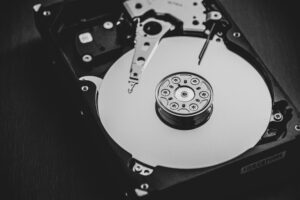
Quelle: Unsplash
Das Jahr 2021 neigt sich dem Ende zu und schon bald beginnt ein ganz neues Jahr voller Möglichkeiten. Es wird also wieder Zeit für ein paar gute Vorsätze. Das Jahr 2021 hat uns deutlich gezeigt, wie wichtig eine gute IT-Infrastruktur ist. Tag für Tag werden Unmengen an Daten erzeugt, bearbeitet und geteilt – sowohl privat als auch im beruflichen Kontext. Doch was tun, wenn diese Daten plötzlich weg sind? Zwar sind sich viele Menschen der Gefahr eines Datenverlustes bewusst, doch nur Wenige sorgen im privaten Kontext aktiv dafür, dass ihre Daten vor einem solchen Verlust geschützt sind. Regelmäßige Backups sollen dafür sorgen, dass keine Daten mehr verloren gehen und sind ein wichtiger Bestandteil der IT-Sicherheit.
Was ist ein Backup?
Unter Backup versteht man die Sicherung von Daten auf einem oder mehreren Speichermedien. Dabei werden die Daten auf einem oder mehrere interne oder externe Datenträger kopiert. Zweck eines Backups ist es, den Verlust von Daten, beispielsweise durch Hardwaredefekte, Softwarefehler oder Hackerangriffe, zu verhindern. Sollte euch die Festplatte eures Computers hängen lassen, euer Smartphone verloren oder kaputt gehen, sind die auf dem Endgerät gespeicherte Daten dank eines Backups noch verfügbar und können problemlos wiederhergestellt werden.
Diese Backups können lokal, also beispielsweise auf einer externen Festplatte, oder online gespeichert werden. Persönliche Backups gelten als besonders sicher, wenn die sogenannte 3-2-1 Regel angewendet wird. Dabei sollen mindestens 3 Sicherheitskopien der Daten erstellt werden, auf mindestens 2 verschiedenen Datenträgern, bei der mindestens 1 dieser Kopien an einem anderen Ort aufbewahrt wird.
Backupverfahren
Es gibt drei verschiedene Backupverfahren: Vollbackup, inkrementelles Backup und differentielles Backup:
Ein Vollbackup ist eine vollständige Sicherung aller Daten. Dabei besteht keinerlei Abhängigkeit zu früheren Backups, da alle Daten einzeln gesichert werden.
Beim inkrementellen Backup hingegen, werden nur die Daten gesichert, die seit der letzten Sicherung hinzugefügt oder verändert wurden. Der wohl größte Vorteil dieses Verfahrens ist die Zeitersparnis, da die Sicherungskopie immer auf die letzte Sicherung basiert und nicht auf das Vollbackup. Dadurch müssen deutlich weniger Daten gesichert werden. Bei einer Wiederherstellung der Daten muss allerdings zuerst das Vollbackup, dann jedes einzelne inkrementelle Backup in chronologischer Reihenfolge wiederhergestellt werden. Alle inkrementelle Sicherungen sind von ihren vorigen Sicherungen abhängig. Sollte es bei einer Sicherung zu Problemen kommen, kann dies zu Problemen mit der gesamten Wiederherstellung führen.
Beim differentiellen Backup werden die Daten immer basierend auf das letzte Vollbackup gesichert. Dabei werden also nur die Daten gesichert, die seit dem letzten Vollbackup hinzugefügt oder geändert wurden. Bei der Datenwiederherstellung muss also erst das Vollbackup, dann lediglich das letzte differentielle Backup wiederhergestellt werden.
Wie lege ich Backups sinnvoll an?
Einige unserer Geräte legen dank vorinstallierter Software automatisch Sicherungskopien an. Dabei werden die Daten meist online abgespeichert. Darüber hinaus bieten diverse weitere Programme sowohl kostenlose als auch kostenpflichtige automatisierte oder halb-automatisierte Backup-Lösungen für den privaten Gebrauch an. Im besten Fall wird das komplette System in regelmäßigen Abständen gesichert, ohne dass ihr explizit daran denken müsst. Dabei solltet ihr jedoch auf die Vertrauenswürdigkeit der Software achten.
Wer privat ganz auf professionelle Unterstützung verzichten möchte, hat ebenfalls die Möglichkeit seine Daten manuell via Handkopie zu sichern. Dafür braucht ihr lediglich einen externen Datenträger und ein bisschen Zeit. Dabei könnt ihr selbst entscheiden, welche Daten ihr kopieren wollt. Wichtig ist vor allem, dass Backups regelmäßig angelegt werden. Das Zauberwort heißt hier also vor allem Disziplin. Wie regelmäßig ihr Backups anlegen solltet, hängt selbstverständlich auch von der Nutzung des Geräts ab. Bei manuellen Backups müsst ihr selbst entscheiden, wie oft und in welchen Zeitabständen ihr diese durchführt.
Es gibt unzählige Möglichkeiten, Backups anzulegen und die eigenen Daten sinnvoll zu sichern. Wichtig ist dabei vor allem eins: es einfach zu tun, im besten Fall lieber öfters als zu selten. Das regelmäßige Anlegen von Backups sollte auf unserer Liste der guten Vorsätze fürs neue Jahr also ganz oben stehen. Dabei können wir den Ärger über Datenverlust genau wie das vergangene Jahr hoffentlich hinter uns lassen.
Ihr findet das Thema besonders spannend und möchtet zusätzlich erfahren wie Datensicherung hochschulübergreifend in NRW funktioniert? Auf der Website des Vorprojekts Datensicherung.NRW erfahrt ihr alles rund um das Betriebsmodell, das die Datensicherung an Hochschulen in NRW in Zukunft nachhaltig und zeitgemäß gewährleisten soll.
Verantwortlich für die Inhalte dieses Beitrags ist Stéphanie Bauens.




